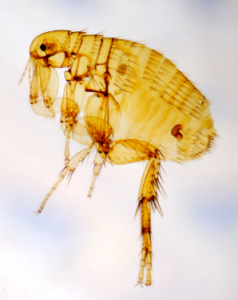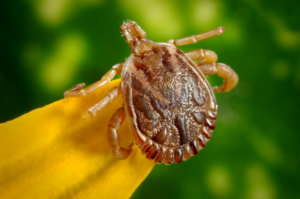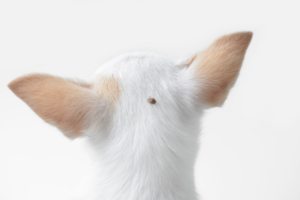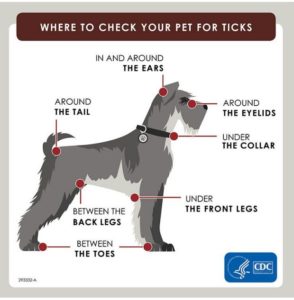How Does My Pet Get Fleas and Ticks?


Fleas develop over a three to four-week life cycle from egg to adult flea. Females will lay their first eggs within a day of reaching adulthood, producing 40-50 eggs per day. They develop outdoors in shady areas; they cannot live in areas exposed to prolonged sunlight. Indoors, they develop in quiet, undisturbed parts of your home, in carpet, under furniture, cracks in your hardwood floors, and along baseboards.
Fleas appearing in your home can be an upsetting sight. How do they get there? The flea eggs are laid on your pet then fall off into your home within a few hours. The eggs are making themselves comfortable as the month-long growth to adult flea begins. Because of the hidden eggs in your home, and the 30-day growth period to adulthood, experts advise that it can take up to 90 days, or 3 months, to rid your pets and your home of fleas.
You may become aware of fleas when you see your pet scratching and acting anxious or annoyed. Some cats and dogs are allergic to the saliva of fleas. This hypersensitivity is known as flea allergy dermatitis. They develop crusting and scabs, red skin, and open wounds from scratching. Infections can develop. Heavy infestations of fleas, especially in young animals, may lead to low iron or anemia.

However, it is possible there will be no signs from your pet of a flea problem, not even scratching. By combing your pet, you can find fleas or their feces, which look like black or reddish specks that don’t move. Owners may also find out a pet has fleas when they develop tapeworms found in their stool. These are rice-like worms, and one of the main sources for these worms is when a pet ingests fleas!
The Companion Animal Parasite Council (CAPC at capcvet.org) recommends year-round use of flea products on your pets to eliminate fleas on pets, in their home environment, and to prevent re-infestation. It can take several months to get fleas under control. Flea products for your pet come in several forms. There are different topical products to choose from, and for dogs, oral products. These products can kill adult fleas only, or prevent fleas from developing normally so they die before adulthood. You may also need to:
- Vacuum carpets, upholstered furniture, under furniture and around baseboards
- Clean surfaces where your pet spends most of their time.
- Launder all bedding the pet sleeps on–this includes yours if your pet sleeps with you as well as pet beds.
- Do all this on a regular basis, as frequently as daily if the flea problem is severe.
- Treat all the pets in the household with a flea product, not just the ones that go outside.

Finally, please be aware that flea products for dogs are highly toxic to cats and should never be used on them.

There are primarily three types of ticks living in the Tri-state area that are a concern for your pet.
- American Dog Tick–can cause Rocky Mountain Spotted Fever and the condition Tick Paralysis
- Blacklegged “Deer” Tick–can cause Lyme disease and Anaplasmosis
- Lone Star Tick–can cause Ehrlichiosis and in cats, Cytauxzoonosis
CAPC recommends pets be treated year round and throughout their life with a tick control product to limit infestations on your pet and reduce the number of ticks in and around your home. Another important consideration is your family members. While people cannot get these diseases from their dog or cat, they can get them from the ticks they bring inside. (Also, note that dogs and cats cannot spread the disease to each other.)
Where can ticks be found in the environment? Depends on the type of tick. Deer and Lone Star ticks are mostly found in wooded areas, and under leaf piles, where wildlife is present, or where deer populations exist. American dog ticks are found in tall, grassy meadows, open woods, particularly along trails, and open fields in agricultural areas. Pets get ticks when they are in these areas and brush against a place with a tick actively trying to catch onto an unsuspecting host. Contrary to popular belief, ticks cannot jump nor do they fall from trees.

Ticks that have disease cause infection when they start feeding off the pet after attaching. Strangely, actual feeding does not start right away. The Deer Tick doesn’t feed for 24-48 hours after attaching. American Dog and Lone Star feed after 3-6 hours. Ticks can stay attached for up to 14 days. Ticks can infect pets and humans at all life stages, not only at adulthood.

You can help prevent the spread of disease by examining your pet after visiting areas know for ticks. If a tick is found, it should be removed promptly with a pair of tweezers as close to the skin as possible. Wear gloves or wash hands well afterward. You can save the tick and bring it to us for possible identification.

Ticks need to be in damp conditions; they dry out and die easily. They thrive in areas with higher humidity and precipitation. Surprisingly, the Deer tick does not need warm weather to survive; it is most active during the fall and winter, which is why it is recommended to use tick prevention year round.
Sometimes, infection can occur where the tick attached itself. Keep an eye on the area after tick removal.
Tick products work in different ways. Oral products travel in the dog’s bloodstream, quickly reaching tissues just under the skin. When the tick bites, their nervous system is affected, and they die. Topical products spread over the pet’s body through body oils, killing the tick before biting.
Important note: Tick products made for dogs should never be used on cats, and cat products shouldn’t be used on dogs!

